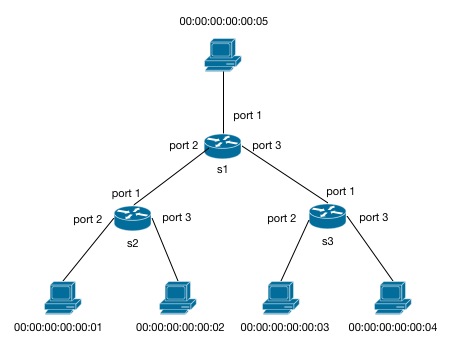Chapter 7: Shortest Path Forwarding with Ox
In this exercise, we will write an application that forwards packets along the shortest paths in a static network topology. This is an essential application that provides the foundation of most networks.
Exercise 1: The Shortest Path Forwarding Function
More specifically, this application will implement the following functionality:
-
It will calculate the shortest paths from each source host to every other host in the topology.
-
For each path, it will install corresponding forwarding rules on the switches. Recall from previous chapters that each rule contains a pattern and an action (as well as a priority and counters). We will use patterns that match on destination addresses and actions that forward to the next hop in the path.
Topology
We will represent network topologies using the data types defined in the [Frenetic_Topology.Net module]. For simplicity, in this tutorial, we will test our code on the tree topologies. The following figure depicts a tree with 5 hosts and 3 switches in a tree of depth 2:

However, the application itself should work with any
Frenetic_Topology.Net.Topology.t.
Programming Task
Fill in the missing code in the template below. Save it in a file
called Routing.ml and place it in the directory
~/ox-tutorial-solutions/Routing.ml.
open Frenetic_Ox
open Frenetic_OpenFlow0x01
open Frenetic_Topology
module Topology = Net.Topology
module MyApplication = struct
include DefaultHandlers
open Platform
let topology = Net.Parse.from_dotfile "topology.dot"
(* creates Mininet script to generate the topology *)
let () =
let fd = open_out "topology.py" in
Printf.fprintf fd "%s" (Net.Pretty.to_mininet topology);
close_out fd
let is_host v =
match Node.device (Topology.vertex_to_label topology v) with
| Node.Host -> true
| _ -> false
(* Creates a list of hosts *)
let hosts =
Topology.VertexSet.filter is_host (Topology.vertexes topology)
(* [FILL] Install rules for each switch *)
let switch_connected (sw: switchId) (feats : SwitchFeatures.t) : unit =
()
(* [FILL] drop all packets that reach the controller *)
let packet_in (sw : switchId) (xid : xid) (pk : packetIn) : unit =
()
end
let _ =
let module C = Make (MyApplication) in
C.start ();
In more detail:
-
To calculate the shortest paths, use the function UnitPath.all_shortest_paths from Network.ml which will returns hashtable mapping each node in the graph to its predecessor along the path back to a given source.
-
Calculate these paths for every host in the network and then convert them into forwarding rules. The function
Topology.vertex_to_labelobtains the information associated with each node such as switch identifiers and host addresses. The functionsTopology.find_edgeandTopology.edge_srcreturn the edge between two nodes and the the source node at the end of the edge respectively. -
Install the rules calculated for each path on each switch as they connect.
-
For simplicity, drop any packets that reach the controller.
Compiling and Testing
-
Build and launch the controller:
$ ./ox-build Routing.native $ ./Routing.native
Launching the controller generates a python script topology.py that
starts Mininet with the topology given above.
-
Start Mininet in a separate terminal window:
$ sudo mn --custom topology.py -
First, test all-pairs connectivity:
mininet> pingall
This should show that 0% of the packets have been dropped.
-
Dump flows on switch 1:
mininet> sh ovs-ofctl dump-flows s1 -
You should receive an output similar to this:
NXST_FLOW reply (xid=0x4): cookie=0x0, duration=90.133s, table=0, n_packets=6, n_bytes=588, idle_age=85, priority=100,dl_dst=00:00:00:00:00:01 actions=output:2 cookie=0x0, duration=90.133s, table=0, n_packets=8, n_bytes=784, idle_age=85, priority=100,dl_dst=00:00:00:00:00:05 actions=output:1 cookie=0x0, duration=90.133s, table=0, n_packets=6, n_bytes=588, idle_age=85, priority=100,dl_dst=00:00:00:00:00:02 actions=output:2 cookie=0x0, duration=90.133s, table=0, n_packets=6, n_bytes=588, idle_age=85, priority=100,dl_dst=00:00:00:00:00:04 actions=output:3 cookie=0x0, duration=90.133s, table=0, n_packets=6, n_bytes=588, idle_age=85, priority=100,dl_dst=00:00:00:00:00:03 actions=output:3
Verify that the packets are being forwarded out of the correct port
based on their destination MAC address. Using ovs-ofctl, dump the
flows on all switches to ensure that packets are being forwarded
along the shortest paths.